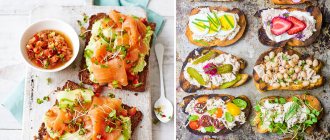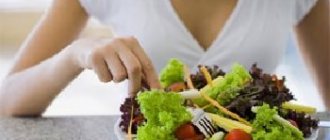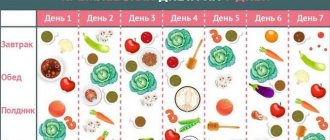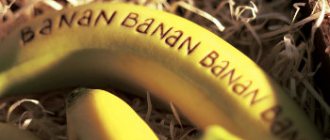Amount of food
Now you have to eat for two, otherwise there won’t be enough milk... Sounds familiar, doesn’t it? Guided by the best intentions and their experience of motherhood, our mothers and grandmothers simply insist on abundant nutrition for the nursing mother. Does breast milk production really depend directly on the amount of food a woman consumes?
To date, a huge number of studies have been conducted that clearly indicate that the amount of milk is in no way related to the amount of food consumed by a nursing mother. All the “excess” eaten will be carefully deposited by the mother’s body on the sides (and not only) of the woman herself.
According to data obtained during research, a baby, regardless of age, “consumes” no more than 300-500 Kcal per day. To take this into account in the mother’s diet, you can introduce an extra snack, for example, a second light breakfast or afternoon snack. The main thing is to observe moderation and remember that after childbirth, the female body goes through a complex recovery process, including hormonal balance, and excess weight that appears due to poor nutrition can create serious additional stress and problems.
Yes or no?
The most questions and disputes are caused by the list of products that are allowed or prohibited, and categorically, for women who practice breastfeeding. The paradox of the situation is that the nutrition of a nursing mother should be as complete as possible (from the point of view of high-quality nutrition for the child), however, there is an opinion that some foods should be excluded, as this can negatively affect the well-being and health of the baby. What should I do?
To answer this question, it is necessary to clearly understand how breast milk is synthesized. If we get away from specialized medical terms as much as possible, then the process can be defined as follows:
- food enters the gastrointestinal tract and the digestion process begins;
- all the necessary nutrients enter the woman’s blood through the intestinal walls;
- With the flow of blood and lymph, these substances enter the area of the mammary gland, which synthesizes breast milk.
That is, all fermentation products, as well as allergens, remain “in the intestines” of the mother. However, if a woman's reaction to the foods she eats is so strong that it affects the composition of her blood, breast milk, or rather its composition, may also change.
To ensure that a nursing mother’s nutrition is complete and that the baby is healthy and cheerful, it is necessary to remember three important rules:
- The nutrition of a woman who is breastfeeding should include the most complete list of products, the composition of which covers her nutritional needs for vitamins and microelements (minerals, biologically active substances, etc.).
- Any “new” products or products that can cause a violent response from the female body (gas formation or an allergic reaction) must be introduced gradually - one product per day. After this, take a break (1-2 days), make sure that there is no negative reaction, after which you can introduce the next one.
- Regardless of the product category, you need to be as prudent as possible and pay special attention to the quantity of products consumed. The “Rule of Reasonability” says that any food can be introduced into food, but in reasonable quantities. Of course, in this case, we are not talking about alcohol or food that can affect the taste of breast milk (which, according to some experts, can cause the baby to refuse the breast).
Moreover, we can say with confidence that the child, while in the womb, has already experienced the effects of almost all nutrients, including allergens. If they continue to come in small quantities through mother's milk, then, most likely, the introduction of complementary foods will take place without any surprises. The child’s body has already learned to cope with them in small doses.
Photo source: shutterstock.com
What can nursing mothers eat from 0 to 3 months?
Despite many restrictions, breakfasts, lunches and dinners for a nursing woman can be varied and tasty. In addition, such nutrition helps to get rid of extra pounds gained during pregnancy. But you won’t have to go hungry and constantly think about delicious food if you know what a nursing mother can eat.
Delicious and healthy breakfasts while breastfeeding:
- Omelette with vegetables. If you're short on time, make it in the microwave. All ingredients can be mixed in 2 minutes, and the omelette will take another 5 minutes. A hearty and healthy protein breakfast is prepared very quickly.
- Toast with cheese, chicken and fresh vegetables. It is best to take whole grain bread, it is healthier for the body. It takes 10-15 minutes to prepare such toasts, and the pleasant aftertaste will remain for the whole day.
- Oatmeal with milk or water. It is not recommended to add nuts or dried fruits, but you can get by with fresh fruits. For example, add a banana. The porridge will be sweeter and remain just as healthy.
- Oatmeal pancake with filling. This dish has become popular in recent years with the advent of nutrition blogs on social networks. As a filling you can use cottage cheese with vegetables, homemade jam and much more. This oatmeal pancake can be made both sweet and salty.
For a snack, you can eat natural yogurt, a slice of homemade pie, seasonal berries or fruits (if your baby does not have a reaction to them).
At any time of the day, a nursing mother can eat the following foods:
- Various cereals. You can include not only oatmeal, but also buckwheat and corn porridge in your diet. They do not affect gas formation and contain many nutrients.
- Lean fish. Look out for pollock, cod, carp or narima. This white fish contains almost no allergens and is well absorbed by the body. The method of preparing fish is also of great importance for the diet during breastfeeding: it can be boiled, steamed or baked in the oven.
- Meat. In the first months after the birth of the baby, it is better to give preference to chicken, turkey and rabbit. In the future, you can also introduce beef and pork into the diet.
- Vegetables. And although some foods need to be avoided (for example, white cabbage), the choice remains large. You can eat broccoli, cauliflower, potatoes, cucumbers, zucchini, asparagus and much more fresh or after heat treatment. Also try adding tomatoes and bell peppers to your dishes: they rarely cause an allergic reaction.
- Fruits and berries. You need to start with bananas and baked apples (fresh apples can lead to problems in the baby’s digestive system). But you shouldn’t be afraid of other fruits, as they contain many vitamins and beneficial elements. You need to start with small portions and carefully monitor whether the child has a reaction.
- Soups. From the first days after childbirth, you can eat soups with vegetables and lean meat. You can also introduce puree soups into your diet.
- Dairy products. The body can react ambiguously to whole milk, but there is no need to give up kefir, cottage cheese, cheeses and other products.
- Rye bread and bran bread. You can use it on toast for breakfast or have a few pieces with soup.
What and how to eat for a nursing mother: basic tips
- Don't skip meals. For normal functioning of the digestive system, you need to eat at least 3 times a day. With snacks, this number can reach up to six.
- Set aside at least half an hour a day to prepare healthy food. Of course, it’s difficult to find time with a baby, but delicious food will have a positive effect not only on your well-being, but also on your mood.
- New foods should be introduced gradually, one at a time. This is necessary in order to be able to monitor the baby’s reaction and, if necessary, eliminate the allergen.
- The serving size of a new product can be increased every 2-3 days.
In the first 3 months after birth, when the baby’s body can most clearly react to the mother’s nutrition, it is important to think about health. Preventing problems associated with allergic reactions is much easier than treating them in the future.
A nursing mother of a newborn can eat a lot if she chooses foods wisely and the way they are prepared. At first, it is better to avoid fried foods or cook them in a non-stick frying pan without using oil. When the baby is one month old, the nursing mother will be able to eat more foods. The main rule: you need to introduce everything new gradually (1 product at a time) and in small quantities.
To ensure that the first months after the birth of the baby pass with maximum comfort, it is important to buy everything necessary for a young mother. Such things include, for example, a milk snood for feeding, with which you can cover your breasts and feed your baby even in a crowded place. The products presented in the Proud Mom catalog are very convenient and practical. They can be worn like regular scarves and protect your neck, face and chest from the wind. Milk snoods are made of natural cotton with the addition of elastane, so they are pleasant to the skin and do not cause irritation.
Plan your diet in such a way as to lose weight comfortably and without harm to your baby. Enjoy every meal, love your body, and be sure to buy things that will make breastfeeding easier. The Russian brand Proud Mom will be happy to help you with this.
Definitely no
Modern researchers confirm the connection between a mother's diet and the quality of breast milk. This means that we can safely say that a nursing mother’s diet should consist of foods that are healthy for her! On the contrary, you should avoid, or even completely abandon, the consumption of foods that:
- increase the load on the gastrointestinal tract, liver, pancreas, and also increase the likelihood of excess weight (this can be fatty, fried and “heavy” foods, canned foods);
- have a negative (currently) effect on a woman’s central nervous system (disinhibiting effect), for example, strong tea (black, green) and coffee;
- contain preservatives, dyes and stabilizers that can affect the hormonal system of a nursing woman, at a time when she is in the process of recovering from childbirth and is most vulnerable.
Menu for the week lactose-free (dairy-free)
If you follow this style of nutrition, you need to consider it as a chance to learn how to cook delicious dishes, cleanse the body, normalize weight, improve carbohydrate metabolism and the condition of the skin of not only the child, but also the nursing mother. Only with a positive attitude does a dairy-free diet bring real benefits.
It is very important that every day in the diet there are products that are an equivalent replacement for those excluded. During lactation, the menu must be balanced in terms of basic nutrients - proteins, fats and carbohydrates, vitamins, as well as calories.
For example, you can use this weekly diet.
Monday:
- buckwheat porridge with stewed apples;
- bananas;
- fish soup with millet, salad of boiled carrots with sesame seeds and cubes of tofu;
- stewed cauliflower and chicken beef stroganoff.
Tuesday:
- oatmeal with dried apricots, flax seeds;
- applesauce;
- vegetable soup, turkey cutlets with buckwheat porridge;
- fish baked with vegetables and herbs.
Wednesday:
- pumpkin porridge with rice;
- tofu and cucumber sandwich;
- broccoli soup with herbs, fish meatballs with mashed potatoes;
- Steam omelette with spinach, boiled carrots.
Thursday:
- oatmeal with dates and apples;
- rice casserole with pumpkin and raisins;
- soup with chicken and noodles, vegetable stew of zucchini, carrots and cauliflower;
- steamed fish with herbs, boiled potatoes and cucumbers.
Friday:
- stewed carrots with apples and dried apricots;
- bananas, oat milk;
- turkey meatball soup, buckwheat porridge with cucumber salad and tofu;
- green pepper stuffed with rice and minced veal.
Saturday:
- oatmeal with apples;
- sandwiches with meat pate and cucumber;
- vegetable soup with oatmeal, fish with boiled potatoes;
- buckwheat porridge with stewed chicken, cucumbers.
Sunday:
- rice porridge with dried apricots and raisins;
- baked apples;
- fish soup, fish balls with pasta;
- turkey with vegetable stew.
Quite strict restrictions must be observed in the first three months, then vegetables (tomatoes, eggplants, young beans, beets), as well as seasonal fruits and berries, are gradually added to the menu. Not allowed throughout the entire feeding period:
- grapes, melon, strawberries, oranges and tangerines;
- fatty fish, caviar;
- honey;
- store-bought sauces;
- smoking, marinades, pickles;
- pork, beef fat;
- strong tea and coffee;
- chips, snacks, sushi, fast food.











